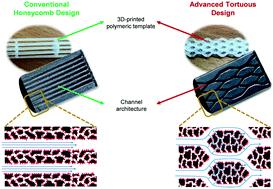当前位置:
X-MOL 学术
›
Catal. Sci. Technol.
›
论文详情
Our official English website, www.x-mol.net, welcomes your
feedback! (Note: you will need to create a separate account there.)
Design and fabrication of integral carbon monoliths combining 3D printing and sol–gel polymerization: effects of the channel morphology on the CO-PROX reaction
Catalysis Science & Technology ( IF 4.4 ) Pub Date : 2021-08-02 , DOI: 10.1039/d1cy01104a Cristian Yesid Chaparro-Garnica 1 , Esther Bailón-García 1 , Dolores Lozano-Castelló 1 , Agustín Bueno-López 1
Catalysis Science & Technology ( IF 4.4 ) Pub Date : 2021-08-02 , DOI: 10.1039/d1cy01104a Cristian Yesid Chaparro-Garnica 1 , Esther Bailón-García 1 , Dolores Lozano-Castelló 1 , Agustín Bueno-López 1
Affiliation

|
A new method to synthesize integral carbon monoliths with a controlled channel morphology has been developed in this work by combining 3D-printing technology and sol–gel polymerization. By this method, robust and consistent carbon monoliths were obtained with a perfect replica of the channel architecture at a microscale range. As a proof of concept, a carbon monolith with tortuous channels that split and join successively along the monolith length has been designed, fabricated and tested as a CuO/CeO2 support for the preferential oxidation of CO in the presence of H2 (CO-PrOx), which is a topic of ongoing research for H2 purification in fuel cells. The behavior of this novel carbon monolith catalyst has been compared with that of a counterpart catalyst prepared with a conventional honeycomb design. Results shown that the wide macroporosity of the carbon network favors the anchoring and dispersion of the active phase both in the channel surface and the carbon network. The channel architecture affects the gas diffusion both through the channel and the carbon network and consequently, affects the active phase accessibility and activity. T50 (the temperature to achieve 50% CO conversion) decreases by almost 13 °C at 240 mL min−1 in the carbon monolith with tortuous channels (T50 = 79.7 °C) compared to the honeycomb monolith (T50 = 93.1 °C). The turbulent path created by the tortuous channels favours the active phase–gas contact and even the gas diffusion inside the macropores of the carbon skeleton improving the catalytic performance of the active phase compared to that by the conventional honeycomb design. Thus, this work demonstrates the potential of 3D printing to improve the catalytic supports currently available.
中文翻译:

结合 3D 打印和溶胶-凝胶聚合的整体碳单块的设计和制造:通道形态对 CO-PROX 反应的影响
在这项工作中,通过结合 3D 打印技术和溶胶-凝胶聚合,开发了一种合成具有受控通道形态的整体碳单块的新方法。通过这种方法,获得了坚固且一致的碳单块,并在微尺度范围内完美复制了通道结构。作为概念证明,设计、制造和测试了一种具有曲折通道的碳单块,这些通道沿着单块长度连续分裂和连接,作为 CuO/CeO 2载体,用于在 H 2 (CO- PrOx),这是 H 2正在进行的研究主题燃料电池中的净化。这种新型碳单块催化剂的行为已与使用传统蜂窝设计制备的对应催化剂的行为进行了比较。结果表明,碳网络的大孔隙率有利于活性相在通道表面和碳网络中的锚定和分散。通道结构影响气体通过通道和碳网络的扩散,从而影响活性相的可及性和活性。Ť 50(温度,从而实现50%的CO转化率)通过近13℃下在240毫升分钟降低-1与曲折通道的碳单块(Ť 50 = 79.7℃)相比,蜂窝状整料(Ť50 = 93.1 °C)。与传统蜂窝设计相比,由曲折通道产生的湍流路径有利于活性相-气体接触,甚至有利于碳骨架大孔内的气体扩散,从而提高了活性相的催化性能。因此,这项工作证明了 3D 打印在改进目前可用的催化载体方面的潜力。
更新日期:2021-08-20
中文翻译:

结合 3D 打印和溶胶-凝胶聚合的整体碳单块的设计和制造:通道形态对 CO-PROX 反应的影响
在这项工作中,通过结合 3D 打印技术和溶胶-凝胶聚合,开发了一种合成具有受控通道形态的整体碳单块的新方法。通过这种方法,获得了坚固且一致的碳单块,并在微尺度范围内完美复制了通道结构。作为概念证明,设计、制造和测试了一种具有曲折通道的碳单块,这些通道沿着单块长度连续分裂和连接,作为 CuO/CeO 2载体,用于在 H 2 (CO- PrOx),这是 H 2正在进行的研究主题燃料电池中的净化。这种新型碳单块催化剂的行为已与使用传统蜂窝设计制备的对应催化剂的行为进行了比较。结果表明,碳网络的大孔隙率有利于活性相在通道表面和碳网络中的锚定和分散。通道结构影响气体通过通道和碳网络的扩散,从而影响活性相的可及性和活性。Ť 50(温度,从而实现50%的CO转化率)通过近13℃下在240毫升分钟降低-1与曲折通道的碳单块(Ť 50 = 79.7℃)相比,蜂窝状整料(Ť50 = 93.1 °C)。与传统蜂窝设计相比,由曲折通道产生的湍流路径有利于活性相-气体接触,甚至有利于碳骨架大孔内的气体扩散,从而提高了活性相的催化性能。因此,这项工作证明了 3D 打印在改进目前可用的催化载体方面的潜力。











































 京公网安备 11010802027423号
京公网安备 11010802027423号